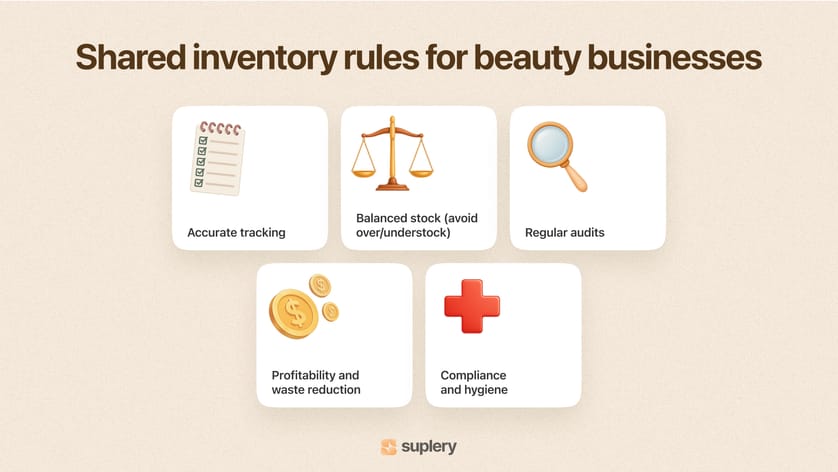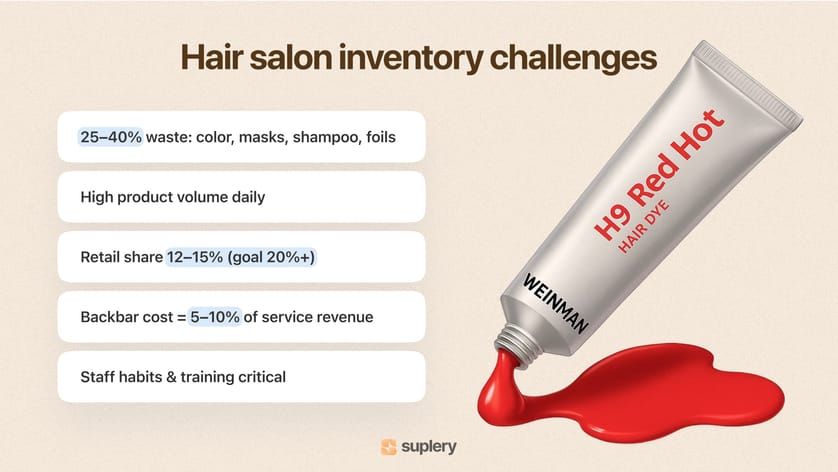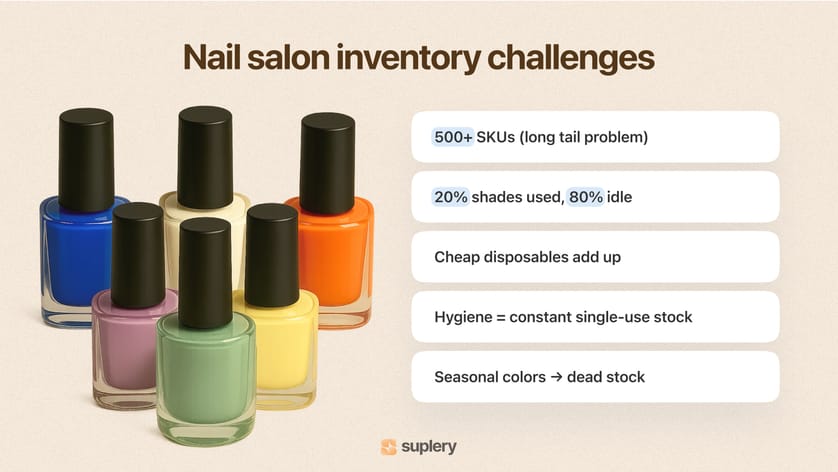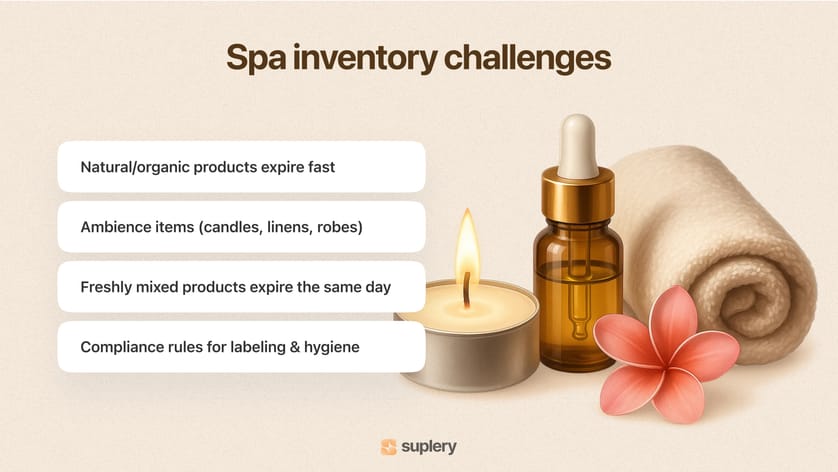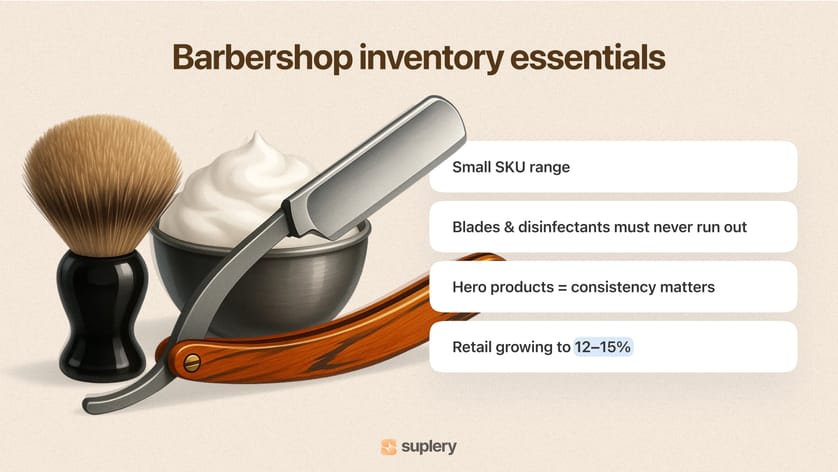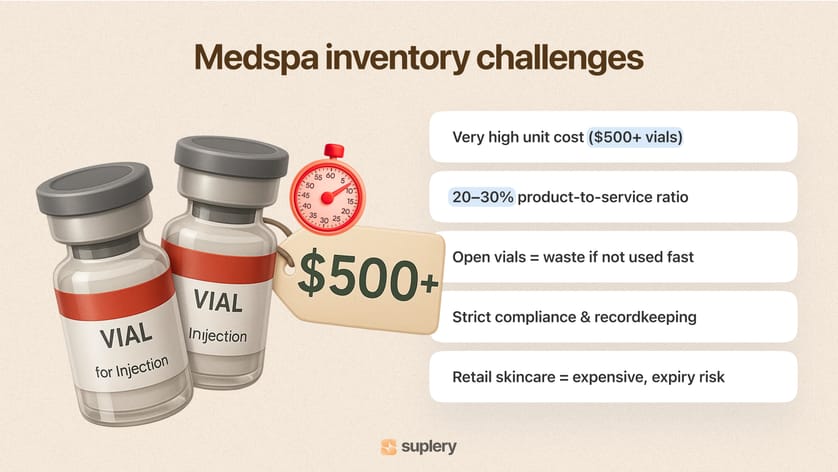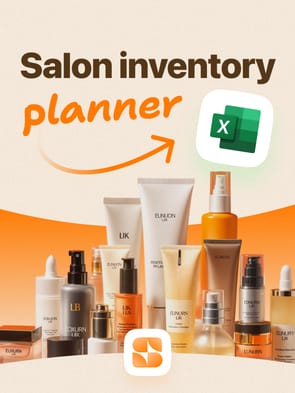Inventory control differences across salons, spas, and barbershops
Let’s be blunt: beauty salon inventory management isn’t the sexy part of running a salon, spa, or medspa. No one gets into beauty because they’re dying to count tubes of hair color or tally nail files. But here’s the truth every owner eventually learns — the right inventory control process can make or break your profit margins.
Run out of a popular color formula mid-appointment? Clients lose trust. Overorder that “must-have” serum line only to watch it expire? That’s thousands of dollars in the trash. Either way, poor inventory control systems bleed cash, tank client experience, and quietly wreck your bottom line.
This article breaks down the core principles of inventory management — the universal rules every beauty business must follow — and then dives into the specific challenges faced by different segments of the industry: hair salons, nail salons, spas, barbershops, and medspas. You’ll see what they all share, what makes each unique, and why tailoring your inventory management system to your business model is the smartest move you can make.
How all beauty businesses are similar in dealing with products
Despite the differences between a nail studio juggling 200 polish colors and a medspa managing $600 vials of Botox, the fundamentals of inventory control systems don’t change. Every successful beauty business masters these five principles of the inventory control process:
Accurate tracking
If you don’t know what you have, you can’t manage it. Accurate, real-time counts are non-negotiable. This means:
- Logging every product and disposable.
- Running regular stock checks (weekly for fast-moving items, monthly for retail).
- Reconciling what the system says with what’s actually on the shelf.
Studies suggest that salons waste up to 25–40% of hair color without realizing it. The fix is simple: better record-keeping and consistent tracking inventory. When you know exactly where your stock levels stand, you reduce waste, keep orders aligned with demand, and improve profitability.
(For tools that make this easier, see our roundup of Best salon inventory management software (2025): pricing, pros & cons — these systems are designed to help you track, reconcile, and improve inventory quality with just a few clicks.)
Avoiding overstock and shortages
Inventory should be a sweet spot: enough stock to meet demand, but not so much that products expire. Overstock ties up cash and hurts cash flow. Understock kills sales, frustrates clients, and lowers customer satisfaction.
Think of it like this:
- Overstock = wasted money.
- Understock = lost money.
Both hurt, but in different ways. The cure? Smarter forecasting. Align orders with service data, track trends, and know your reorder points.
Regular audits and reconciliations
“What gets measured gets managed.” A monthly walk-through to count bottles, check expiry dates, and flag shrinkage (theft, loss, damage) keeps your team accountable. In beauty, where items are small and consumable, it’s too easy for stock to “vanish.” Consistent inventory counts and regular audits are non-negotiable for proper control.
Focus on profitability and waste reduction
Every ounce of product sitting in your backbar represents cash. The golden rule: product cost should stay within 5–10% of service revenue for salons and spas. Medspas, with higher-cost injectables, may run closer to 20–30%, but precision is even more critical there.
Waste in beauty businesses is shockingly high — 25–40% of hair color gets thrown away without controls. FIFO (first-in, first-out) storage, portion control, and staff training are how you protect your margins and minimize costs.
(For owners specifically looking to trim waste and costs, our article Cut inventory costs in salon: save on salon inventory & optimize stock offers step-by-step strategies you can put into practice.)
Compliance and hygiene standards
Inventory isn’t just financial — it’s about client safety and legal compliance. Expired skincare, improperly stored chemicals, or reused disposables can put your license at risk. Every business type must manage stock with hygiene and safety standards in mind: fresh blades in barbershops, sterilized tools in nail salons, batch tracking in medspas.
Bottom line: All beauty businesses share the same backbone — track everything, balance stock levels, audit regularly, reduce waste, and stay compliant. But how you apply these principles depends heavily on the type of business you run.
Hair salons inventory challenges
High product volume, 25–40% waste risk, 12–15% retail share, target backbar cost 5–10% of service revenue.
The high-volume, high-waste reality
Hair salons are product-intense environments. Between color tubes, developers, foils, and backbar shampoos, the inventory footprint is massive. The biggest challenge? Waste across multiple categories.
Stylists routinely over-mix color “just in case.” Leftover dye goes down the drain — studies show 25–40% of salon hair color is wasted this way. But color isn’t the only issue: oversized scoops of masks, too many pumps of shampoo, and stacks of foil thrown out mid-service all add up. Altogether, uncontrolled habits can quietly drain thousands in profit each year.
Smart salons fight back with:
- Digital scales + apps to measure exact formulas.
- Smaller initial mixes with top-ups if needed.
- Measured pumps for shampoos and treatments.
- Staff training to treat every drop of product like liquid gold.
To see how real salons fixed this, check out From stock chaos to profit: 6 salon inventory case studies — it’s full of stories where simple changes in color mixing saved thousands.
Retail: the hidden profit driver
Retail accounts for an average of 12–15% of salon revenue, with high performers hitting 20%+. The challenge is balance: stock enough variety to meet client needs without filling shelves with dusty bottles. Effective inventory management systems help owners monitor inventory quality and keep turnover high.
Staff habits make or break margins
Every stylist’s pour, pump, and scoop impacts profitability. Training them to portion correctly, measure accurately, and see the link between product cost and profit is essential. A culture of accountability — where stylists log usage and own their part in inventory control — separates profitable salons from cash-bleeders.
Nail salons inventory management issues
500+ SKUs, low unit cost per item, heavy reliance on disposables, hygiene rules drive stock needs.
The long tail problem
Nail salons thrive on variety: 100–200 shades of polish, dozens of glitters, dipping powders, decals. But here’s the kicker: clients only use about 20% of those colors regularly. The rest? They sit until they separate, thicken, and die.
Challenge: how do you offer variety without drowning in excess inventory?
- Rotate out rarely used colors.
- Run promos on underused shades.
- Curate a tighter palette — no one needs ten almost-identical blues.
Smart use of inventory management systems helps nail salon owners see which SKUs move and which don’t, so they can make decisions backed by data instead of impulse.
Consumables chaos
A single manicure uses files, buffers, cotton pads, tips, glues, foils — most single-use. Because they’re cheap, owners often bulk buy and forget. But cluttered backrooms = hidden waste. Adhesives dry out, disinfectants expire, money leaks, and cash flow suffers.
Pro tip: Organize disposables with labeled bins and reorder alerts. Treat “cheap” items like they matter — because together, they do. Clean inventory records and consistent inventory counts keep even low-cost items under control.
Hygiene and compliance
State boards often require single-use files or strict sanitation. That means hundreds of fresh tools in stock at all times. Forecasting and budgeting for this disposable load is critical to avoid service interruptions and compliance fines. This is where inventory control processes intersect with business operations — ensuring hygiene while keeping costs predictable.
Seasonal trends
Clients shift with seasons — pastels in spring, deep tones in fall, glitter at holidays. Overordering trend products leads to obsolete stock by January. Smart nail salons align inventory with promotions and client data, not just impulse buys.
Spas & wellness centers inventory problems
Mix of skincare, organic products, and ambiance items; short shelf life; constant linen and candle turnover.
Shelf-life struggles
Spas lean heavily on natural and organic products. Great for branding, terrible for inventory. Essential oils oxidize, scrubs grow mold, masks lose potency fast. Overstocking on “clean beauty” often means half the batch expires before use.
Solution:
- Order in smaller, frequent batches.
- Label everything with open dates.
- Enforce FIFO ruthlessly.
Using inventory control techniques like FIFO and cycle counting helps reduce waste while protecting margins. Smaller batch orders also improve cash flow.
Ambience inventory
Candles, incense, diffusers, linens, robes. These aren’t optional — they define the spa experience. But they also chew up budget and require constant reordering. Towels wear out. Candles burn through fast. Spa managers must track ambience items just like skincare stock. Consistent regular audits of these categories keep carrying costs in check.
Self-prepared treatments
Here’s a unique challenge: many spas create custom masks, scrubs, or oil blends on-site. That means raw inventory (herbs, oils, fruits, clays) with micro shelf lives. Mix too much, and it spoils by day’s end.
Smart spas:
- Standardize small-batch recipes.
- Track raw ingredient use per booking.
- Label and discard daily — no “maybe tomorrow” jars.
Compliance matters too. In some jurisdictions, even in-house mixes need labeling and date tracking. Maintaining detailed inventory records and purchase orders helps spas stay compliant and organized.
(For broader strategies that tie spa operations to profitability, see Reducing salon costs: effective strategies for expense management — it covers how small efficiencies across supplies and stock handling add up to big savings.)
Barbershops inventory control essentials
Small SKU range, blades and disinfectants as essentials, retail slowly growing to 12–15% of revenue.
Simpler, but no less serious
Barbershops carry fewer SKUs than salons, but that doesn’t mean inventory management is effortless. Essentials include clippers, blades, disinfectants, and a few hero products (pomades, gels, aftershaves). With such a narrow range, inventory quality and consistent inventory records become critical.
Blade management = business continuity
By law, blades must often be single-use. That means a constant flow of fresh blades. Run out mid-day? You stop cutting. No excuses. Barbershops must bulk order essentials and set reorder points to avoid disaster. Good supplier relationships help ensure steady delivery and prevent service interruptions.
Brand consistency matters
Clients expect the same pomade, tonic, or aftershave every visit. If a supplier back-orders or discontinues your hero product, you scramble. Always keep a backup brand in mind — it’s part of organizational control and ensures smooth business operations.
Retail opportunity
Retail hasn’t always been core to barbershops, but modern shops are changing that. Beard oils, grooming kits, even branded merch can push retail sales to 12–15% of revenue — if managed smartly. Limited space means each product must earn its keep, making inventory control techniques essential to avoid excess inventory or obsolete stock.
Medspas / aesthetic clinics inventory practices
Very high unit cost ($500+ vials), 20–30% product-to-service ratio, strict medical compliance and recordkeeping.
High cost, high stakes
Medspas handle the priciest, most regulated inventory in the beauty industry: injectables, fillers, medical-grade skincare. A single vial of filler might cost $500+. That’s more than an entire nail salon’s polish wall.
This means:
- Product costs can be 20–30% of service revenue.
- A single expired vial wipes out profit from multiple treatments.
Precise inventory control processes and strong scheduling protect margins. One small mistake in tracking can mean thousands lost.
The “can’t save it” problem
Opened vials of Botox or filler often must be used within hours. If patient scheduling doesn’t align, half a vial — and $300+ — goes in the trash. The challenge is precise scheduling, smarter forecasting, and tighter inventory management systems that help providers maximize usage while minimizing waste.
Compliance and record-keeping
Medspas must track lot numbers, expiry dates, and patient usage for every product. Add strict storage (temperature, light, refrigeration) and regulatory audits, and inventory becomes as complex as in a hospital. Regular audits and clear inventory records aren’t optional — they’re legally required.
Retail & upsell
Medspas also sell medical-grade skincare. These products are expensive and expire if left unsold. Success here means carrying only what providers truly believe in and actively prescribe. Accurate purchase orders and constant tracking inventory help ensure turnover without inflating carrying costs.
Key differences across business types — and why they matter
So, what separates inventory control challenges across the beauty industry?
- Volume vs. variety:
- Hair salons = high-volume items like color tubes.
- Nail salons & spas = high-variety SKUs (hundreds of polishes, oils, or linens).
- Barbershops = fewer items, but essential availability is non-negotiable.
- Cost per unit:
- Medspas face the highest unit costs (one vial = hundreds of dollars).
- Nail salons have the lowest (files and polishes).
- Hair salons and spas sit in the middle.
- Waste risk:
- Hair salons waste color.
- Spas waste perishables.
- Medspas waste expensive opened products.
- Nail salons waste through dead stock.
- Barbershops waste the least.
- Compliance requirements:
- Medspas = hospital-level standards.
- Spas = expiration and hygiene rules.
- Hair & nails = sanitation protocols.
- Barbershops = most relaxed, but sanitation still critical.
Why it matters: Because a one-size-fits-all system doesn’t work. A medspa needs advanced inventory management software, a barbershop needs a simple checklist, and a nail salon needs SKU control. Tailoring your inventory control systems to your business type maximizes profitability, improves customer satisfaction, and ensures compliance.
(If you want to explore broader strategies for staying competitive, check Six clever ways to diversify your salon’s revenue streams — inventory efficiency is one piece of a larger puzzle that keeps your business future-ready.)
Turn inventory into profit
Inventory is the silent profit lever in every beauty business. Ignore it, and you bleed cash. Master it, and you unlock higher margins, smoother operations, and happier clients. Strong inventory control systems not only protect profit but also improve customer satisfaction by ensuring products are always available.
The principles don’t change: track accurately, avoid over/understock, perform regular audits, minimize waste, and stay compliant. But execution must fit your business model and align with your inventory management system:
- Hair salons: crack down on color waste and retail dead stock using clear inventory control techniques.
- Nail salons: tame the long tail of polishes, monitor inventory counts, and control disposables.
- Spas: watch shelf life, manage custom blends smartly, and keep carrying costs low.
- Barbershops: never run out of blades, set strict reorder points, and leverage retail strategically.
- Medspas: treat inventory like gold — precise dosing, zero waste, detailed inventory records, and strict compliance.
Your next move: Audit your inventory this month. Compare stock to revenue. Ask: are product costs within target % of service revenue? Are you sitting on expired, excess, or idle stock? Small changes — a digital scale, FIFO storage, tighter SKU selection, or even upgrading to professional inventory management software — can recapture thousands and free up cash flow.
Inventory may not be glamorous, but for salon owners who master it, it’s the difference between just surviving and thriving in the beauty industry.
 The latest articles and industry insights delivered to your inbox
The latest articles and industry insights delivered to your inbox
Subscribe to receive a monthly digest of our most valuable resources like blog posts, whitepapers, and guides.
Oh no! We couldn’t subscribe you ☹️
Done! You've subscribed 💛
Unsubscribe anytime. Your data is stored for business-to-business communication purposes. See our Privacy policy.
Frequently asked questions
What is the difference between a perpetual inventory system and a periodic system?
A perpetual inventory system updates stock levels in real time through software and POS integration, while a periodic system relies on scheduled counts (weekly, monthly, or quarterly). Small nail salons often use periodic systems, while larger salons and medspas benefit from perpetual systems for accuracy and efficiency.
How does ABC analysis help salons manage inventory?
ABC analysis classifies products by value and usage:
- A items = high-value and high-frequency (hair color tubes, fillers).
- B items = medium-value (shampoos, nail gels).
- C items = low-value, bulk disposables (cotton pads, foils). This approach keeps focus on what really drives profit while avoiding obsolete stock in storage.
What role does cycle counting play in inventory control?
Cycle counting is the practice of checking small sections of stock on a rolling basis. Instead of waiting for one large annual physical inventory, salons can count a portion of SKUs weekly or monthly. This reduces errors, helps spot shrinkage quickly, and strengthens organizational control over stockrooms.
What is economic order quantity (EOQ) in beauty businesses?
Economic order quantity (EOQ) calculates the ideal order size that balances ordering costs with holding costs. For salons, it helps determine how much to buy without tying up cash in excess inventory or driving up carrying costs. For example, ordering too many seasonal nail polishes risks spoilage and wasted money.
Why are purchase orders important in inventory management?
Creating accurate purchase orders ensures consistent supply, keeps inventory records clean, and prevents over-ordering. Combined with strong supplier relationships, they allow owners to negotiate better deals and keep business operations stable.
How do warehouse managers relate to beauty businesses?
Large salon chains or spa franchises may hire staff similar to warehouse managers to oversee bulk stock, storage, and compliance. In smaller businesses, these responsibilities often fall to salon managers — but having clear organizational control over inventory is just as important.
What are carrying costs, and how do they affect salons?
Carrying costs are the expenses tied to holding inventory, such as rent for storage, refrigeration for medspa injectables, insurance, and depreciation. High carrying costs tie up cash flow and reduce profitability. Tracking them ensures owners can minimize costs without risking shortages.
How do financial reports connect with inventory management?
Accurate inventory data feeds directly into financial reports, showing real cost of goods sold, profit margins, and sales volume. Without clean data, waste and shrinkage stay hidden. Integrating inventory systems with accounting makes it easier to analyze trends and reduce storage costs.
How can salons deal with existing inventory more effectively?
Existing inventory is the stock already on your shelves. Managing it well means rotating products (FIFO), running promotions on slow movers, and avoiding obsolete stock. Regularly auditing existing inventory also keeps customer satisfaction high by ensuring fresh, available products.
How can salons minimize costs while still meeting demand?
The key is balancing inventory control techniques: setting accurate reorder points, using EOQ for orders, applying ABC analysis, and enforcing cycle counting. Together, these practices help minimize costs while keeping clients happy and services uninterrupted.
Last updated on Sep 30, 2025
This is a brand-new guide on how inventory control works across salons, barbershops, nail studios, spas, and medspas — with fresh data, profit benchmarks, and waste-reduction practices tailored to each type of business.
Professional Beauty Association (PBA) — profitability metrics and salon business management
Waste360 — waste statistics for salons in the U.S. and Canada
Green Circle Salons — certified program for salon waste recycling and sustainability
OSHA (Occupational Safety and Health Administration, U.S.) — safety standards and chemical storage for salons
FDA (U.S. Food and Drug Administration) — regulations on medical products and storage (relevant for medspas)
Please share this post
Table of Contents
How all beauty businesses are similar in dealing with productsHair salons inventory challengesNail salons inventory management issuesSpas & wellness centers inventory problemsBarbershops inventory control essentialsMedspas / aesthetic clinics inventory practicesKey differences across business types — and why they matterTurn inventory into profitFrequently asked questionsHow to open a barbershop in 2025 | The insider's guide
Learn this step-by-step guide on how to open a successful barbershop. From finding the right location to creating a business plan, we cover it all.
Salon business
15 min
How much does a salon owner make | Average salon owner salary
Want to know how much a beauty business owner can make? Our comprehensive guide has got you covered. Explore the factors that affect salaries, discover industry trends, and get valuable tips for success in the beauty business.
Beauty salon operations & Team management
7 min
Cost to open a nail salon in 2025 | Expenses guide
Discover the comprehensive expenses guide for opening a nail salon in 2025. From rent and licenses to equipment and marketing costs, learn the ins and outs of starting a successful salon venture.
Salon business
11 min
Unlock FREE bonus material!
Get your hands on "Salon order planner by Suplery". Subscribe to our newsletter and receive a link to download it straight to your inbox.
Oh no! We couldn’t subscribe you ☹️
Done! We've sent a link to your Email 📨
Trusted by the best in the beauty industry.
Transform your beauty business with Suplery!
Already enjoying our expert tips? Take the next step and join Suplery to revolutionize your business operations.
Huge range of professional products
One-click checkout after first order
Automated predictive orders
Seamless inventory management
From words to action
Start working with Suplery and explore all the tools and services you need to expand your business
Get started with Suplery24/7 Support
Secure payments
Designed by industry’s experts

